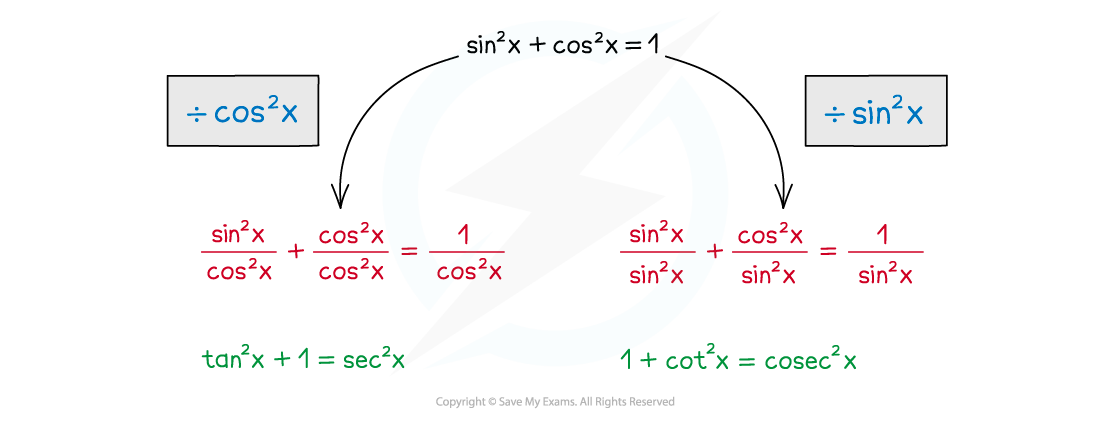Trigonometric Identities (Cambridge (CIE) IGCSE Additional Maths): Revision Note
Exam code: 606
Did this video help you?
Simple trig identities
What is a trigonometric identity?
Trigonometric identities are statements that are true for all values of
or
They are used to help simplify trigonometric equations before solving them
Sometimes you may see identities written with the symbol ≡
This means 'identical to'
What trigonometric identities do I need to know?
The two trigonometric identities you must know are
This is the identity for tan θ
This formula does not appear in the list of formulae
This is the Pythagorean identity
Note that the notation
is the same as
This formula appears in the list of formulae
Rearranging the second identity often makes it easier to work with
Where do the trigonometric identities come from?
You do not need to know the proof for these identities but it is a good idea to know where they come from
From SOHCAHTOA we know that
The identity for
can be seen by diving
by
?
This can also be seen from the unit circle by considering a right-triangle with a hypotenuse of 1
The Pythagorean identity can be seen by considering a right-triangle with a hypotenuse of 1
Then (opposite)2 + (adjacent)2 = 1
Therefore
Considering the equation of the unit circle also shows the Pythagorean identity
The equation of the unit circle is
The coordinates on the unit circle are
Therefore the equation of the unit circle could be written
How are the trigonometric identities used?
Most commonly trigonometric identities are used to change an equation into a form that allows it to be solved
They can also be used to prove further identities
Examiner Tips and Tricks
If you are asked to show that one thing is identical (≡) to another, look at what parts are missing
For example, if tan x has gone it must have been substituted
Worked Example
Show that the equation can be written in the form
, where
,
and
are integers to be found.
Substitute into the equation to form a quadratic in terms of
.
Expand the bracket.
Rewrite in the required form.
or
Did this video help you?
Further trig identities
What are the identities linking tan, sec, cot, and cosec?
Aside from the Pythagorean identity sin2x + cos2x = 1 there are two further Pythagorean identities you will need to learn
Both can be found in the list of formulae
Both of these identities can be derived from sin2x + cos2x = 1
To derive the identity for sec2x divide sin2x + cos2x = 1 by cos2x
To derive the identity for cosec2x divide sin2x + cos2x = 1 by sin2x

How do I prove new trigonometric identities?
You can use trigonometric identities you already know to prove new identities
To prove an identity start on one side and proceed step by step until you get to the other side
It is more common to start on the left hand side but you can start a proof from either end
Occasionally it is easier to show that one side subtracted from the other is zero
You should not work on both sides simultaneously
Look for anything that could be a part of one of the above identities on either side
For example if you see
you can replace it with
Look for ways of reducing the number of different trigonometric functions there are within the identity
For example if the identity contains tan θ, cot θ and cosec θ you could try
Using the identities tan θ = 1/cot θ and 1 + cot2 θ = cosec2 θ to write it all in terms of cot θ
Or rewriting it all in terms of sin θ and cos θ and simplifying
Often you may need to trial a few different methods before finding the correct one
Always keep an eye on the 'target' expression – this can help suggest what identities to use
Examiner Tips and Tricks
Writing down all the identities you know can be a good way to spot how to get started on a question
Worked Example
Solve the equation 9 sec2 θ – 11 = 3 tan θ in the interval 0 ≤ θ ≤ 2π. Give your answers to three decimal places.
The squared term can be rewritten using the identity . Substitute this into the equation.
Rearrange to form a quadratic.
Treat as a quadratic using .
Substitute back in and find the principal value for each equation.
Find the other solutions in the interval by adding multiples of π.
Ignore the solution that is outside the interval (-0.3217...). Round the other four to three decimal places.

Unlock more, it's free!
Did this page help you?